HiPP Dutch vs. HiPP German Formula
61 hours of research 6 minute read

For parents, nothing comes before the health and well-being of their children. Prior making a decision about which baby formula to feed their babies, they do the following:
- List down non-negotiables. Here are common items on the list: organic, clean, nutritious, and healthy.
- They conduct extensive research about products.
- They read plenty of reviews of fellow parents.
- They test if the product is a good fit to their baby.
Parents have a common question for HiPP: Are all HiPP Formulas the same?
Quick answer: NO
HiPP, one of the most popular European organic baby formulas, have different formula versions. Two of the of popular are HiPP Dutch and HiPP German.
On this blog we will cover the following:
- Why are there different versions of HiPP formula?
- What are the similarities of HiPP Dutch and HiPP German?
- What are the differences between HiPP Dutch and HiPP German?
- HiPP Dutch and HiPP German Comparison Table
- Pros and Cons of HiPP Dutch and HiPP German
Why Are There Different Versions of HiPP Formula?
Each country has different nutritional requirements. HiPP understands this and makes baby formula that fits the needs of each country.
What Are The Similarities Between HiPP Dutch and HiPP German?
1. Nutritionally Complete
HiPP Dutch and HiPP German offer complete nutrition for babies. Both versions contain Omega 3 ALA, Omega 3 DHA and Omega 6 for the brain, prebiotics and probiotics for the gut, and essential vitamins and minerals for a baby’s development.
2. Organic
HiPP Dutch and HiPP German are certified organic. These two formulas significantly exceed all European Union requirements for organic certification. There are no GMOs, sugar, corn syrup in the ingredients. Both formulas are also free from artificial preservatives, hormones, and pesticides.
3. Lactose as Primary Source of Carbohydrates
HiPP Dutch and HiPP German are lactose-based and from organic skimmed milk.
4. Manufactured in Germany
HiPP Dutch and HiPP German are both manufactured in Germany.
What Are The Differences Between HiPP Dutch and HiPP German?

1. Starch as Secondary Source of Carbohydrates
Some HiPP German formulas contain starch (with the exception of HiPP German Stage Pre and HiPP German Stage 2 – No Starch).
2. HiPP German Has Specialty Formulas
Compared to HiPP Dutch, HiPP German offers a range of specialty formulas for babies with reflux, sensitivity, and allergies:
✓ Contains Probiotics & Prebiotics
✓ No sugar, no corn syrup, no soy
✓ Organic locust bean gum makes formula creamier
✓ Popular for babies that spit-up
Check Price✓ Contains Probiotics & Prebiotics
✓ No sugar, no corn syrup, no soy
✓ Reduced lactose with hydrolyzed milk protein
✓ Easy to digest formula for sensitive babies
Check Price✓ Contains Probiotics & Prebiotics
✓ No sugar, no corn syrup, no soy
✓ Hydrolyzed milk proteins reduce allergic reactions
✓ Popular for constipated babies
Check Price3. HiPP Dutch Has Goat Formula Options
Compared to HiPP German, HiPP Dutch has a goats’s milk version: HiPP Dutch Goat.
4. Packaging
HiPP Dutch comes in 800g cans, while HiPP German comes in 600g boxes. The Dutch version has both Dutch and French language instructions, whereas HiPP German instructions are only in German.
5. Packaging Location
HiPP German is packaged in Germany whereas HiPP Dutch is packaged in the Netherlands.
HiPP Dutch vs. HiPP German Key Differences
| HiPP German
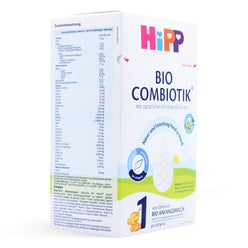 |
HiPP Dutch
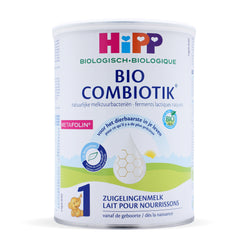 |
|
|---|---|---|
|
Starch |
Present | Not Present |
|
Soy Lecithin |
Present in Stage 2 | Not Present |
|
Headquarters |
Manufactured and packaged in Germany | Made in Germany but packaged in the Netherlands |
HiPP Dutch vs. HiPP German Detailed Comparison
HiPP Dutch
|
Age | EU Certified Organic & non-GMO | Probiotics | Prebiotics | Whey | Lactose | Starch | Maltodextrin | Soy | Omega-3 ALA | Omega-3 DHA | Omega-6 | Packaging | Content |
|---|---|---|---|---|---|---|---|---|---|---|---|---|---|---|
| HiPP Dutch Stage 1 | 0-6 months | Yes | Yes | Yes | Yes | Yes | No | No | No | Yes | Yes | Yes | Can | 800g |
| HiPP Dutch Stage 2 | 6-12 months | Yes | Yes | Yes | Yes | Yes | No | No | No | Yes | Yes | Yes | Can | 800g |
| HiPP Dutch Stage 3 | 12+ months | Yes | Yes | Yes | Yes | Yes | No | No | No | Yes | Yes | Yes | Can | 800g |
HiPP German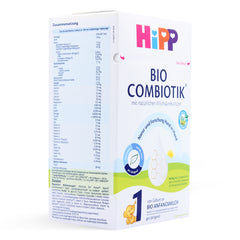
|
Age | EU Certified Organic & non-GMO | Probiotics | Prebiotics | Whey | Lactose | Starch | Maltodextrin | Soy | Omega-3 ALA | Omega-3 DHA | Omega-6 | Packaging | Content |
| HiPP German Stage Pre | 0+ months | Yes | Yes | Yes | Yes | Yes | No | No | No | Yes | Yes | Yes | Box | 600g |
| HiPP German Stage 1 | 0-6 months | Yes | Yes | Yes | Yes | Yes | Yes | No | No | Yes | Yes | Yes | Box | 600g |
| HiPP German Stage 2 | 6-12 months | Yes | Yes | Yes | Yes | Yes | Yes | No | No | Yes | Yes | Yes | Box | 600g |
| HiPP German Stage 2 No Starch | 6-12 months | Yes | Yes | Yes | Yes | Yes | No | No | No | Yes | Yes | Yes | Box | 600g |
| HiPP German Stage 3 | 12+ months | Yes | Yes | Yes | Yes | Yes | Yes | No | No | Yes | Yes | Yes | Box | 600g |
Pros and Cons of HiPP Dutch and HiPP German
To help you better understand each version of HiPP baby formulas, here is the pros and cons list of the HiPP Dutch and HiPP German products line.
✓ Contains Probiotics & Prebiotics
✓ No sugar, no corn syrup, no soy
✓ No starch
✓ HiPP's most popular formula
Check Price| Pros | Cons |
|---|---|
|
|
✓ Contains Probiotics & Prebiotics
✓ No sugar, no corn syrup
✓ No soy, but does contain Lecithin as an emulsifier
✓ Popular for constipated babies
Check Price| Pros | Cons |
|---|---|
|
|
HiPP Dutch vs HiPP German
Both HiPP Dutch and HiPP German are organic healthy options for your baby. We prepared this guide for you to help you in deciding which formula fits your requirements.
In addition, for those comparing HiPP Dutch vs German formulas, it's essential to consider factors like ingredients, nutritional content, and your baby's individual needs. Some parents may find HiPP Dutch more suitable for their little ones, while others might prefer HiPP German. The choice between HiPP Dutch and German formulas ultimately depends on your baby's preferences and dietary requirements.
For example, for those exploring HiPP Dutch Stage 3 or HiPP Stage 2 Dutch, it's crucial to look into the specific attributes and benefits each stage offers. Understanding the nutritional components and formulation details can guide you in making an informed decision.
If you’re still not sure which formula is best suited for your baby, get in touch with Organic Life Start’s customer support department. We will help you choose the right baby formula in accordance with your baby’s nutritional needs.
Most Popular HiPP Formula
Organic Life Start is committed to providing accurate, reliable, and trustworthy information to parents and caregivers. We carefully choose credible sources and follow a meticulous fact-checking process to uphold the highest standards in infant nutrition and parenting advice. To learn more about our dedication to accuracy, please explore our editorial guidelines.
Link To Sources


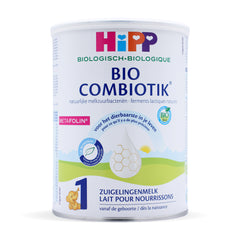
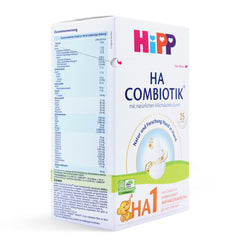
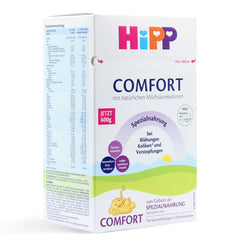









Kelli Nolasco -
I hear so many different opinions on whether Dutch vs. German HiPP formulas really make a noticeable difference in things like fussiness, digestion, or growth. What do you think?
Cameron Donald -
December 15, 2025
As a new mom, I always worry about which formula is really best for my baby. There are so many options, and I want to make sure the ingredients are safe and healthy. I’ve read about differences between HiPP Dutch and HiPP German formulas, but it’s still confusing. My baby sometimes has a sensitive stomach, so I’m extra cautious about what I choose. Does anyone else feel the same way? How did you decide which formula to try first? I’d love to hear any advice on what worked best and what to watch out for. Choosing the right formula feels stressful, and it helps to know I’m not alone in figuring this out.
Barbara Carrier -
December 11, 2025
I never knew that HiPP Dutch was such a great formula until we finally gave it a try for our baby. At first, we were unsure if switching would make any real difference, but we were willing to explore every option for her comfort. Once we started using it, we noticed positive changes that we didn’t expect. Her digestion seemed calmer, and she became less fussy after feedings. We also discovered how clean and gentle the ingredients are, which gave us more confidence in what we were giving her. Through the process, we realized that not all formulas work the same for every baby. HiPP Dutch showed us that even a small change can create a big improvement. We learned to trust our instincts and keep searching until we found what truly worked. As parents, it felt reassuring to finally see our baby more relaxed and content. Trying HiPP Dutch turned out to be one of the best decisions we made for her well-being.